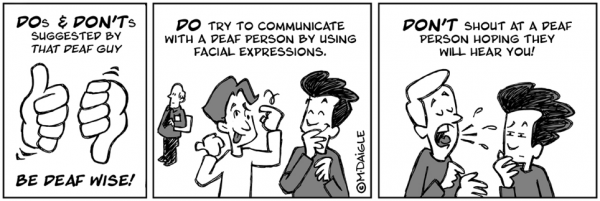
While norms may change from community to community and person to person, there are some common behaviors accepted throughout the Deaf community. While some such behaviors may be considered rude in a group of hearing individuals, they may be actually quite acceptable within the Deaf community. Deaf community norms include:
- Maintaining eye contact.
- Being blunt and direct, whether in description or opinion.
- Waving, tapping the shoulder, stamping on the floor, banging on the table, and turning the lights on and off to get someone's attention.
- Touching during conversations.
- Hugging when greeting or leaving.
- Long goodbyes (saying goodbye to multiple people and engaging in further conversation during this process).
- Walking between persons who are using sign language to communicate.
- Exaggerated facial expressions in conjunction with the use of ASL (Facial expressions are an important part of communication in Sign. Additionally, Deaf people learn to read facial expressions when communicating with hearing people. It is very important to be mindful of body language when communicating with a Deaf person.)
- Sharing of information which might typically be considered personal to themself and others. This is due to the collective nature of the Deaf community, and can be a serious barrier for advocates who struggle to help their Deaf clients understand the importance and/or meaning of confidentiality.
The resources provided below review values and norms in Deaf culture and offer guidance around etiquette for hearing individuals including ASL students and signers.









